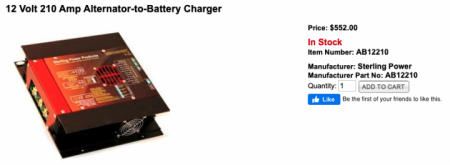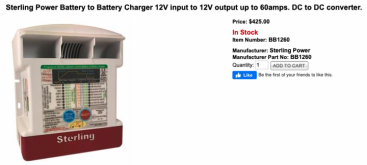MetalChef
New Member
- Joined
- Aug 16, 2020
- Messages
- 25
Update on Sterling Power A2B (Alternator to Batter charger) vs. Sterling Power B2B (Battery to Battery charger). Which works better to use while charging LiFePO4 batteries from your high output alternator? Recently I was searching everywhere for an alternative to the Renogy DC to DC 60a charger (which Renogy says "they do not recommend combining more than 1 Renogy DC to DC charger together) as well as an alternative to the Victron 30a Orion 12v/12v DC to DC charger as stacking Victron DC to DC chargers $263.50 p/ 30a just gets too expensive when you add them up. So my internet research found that Sterling Power sells an A2B and they also sell a B2B (DC to DC) charger. But no where on the internet could I find out what the real differences were between these 2 devices so I sent Sterling a question and they answered as follows: QUESTION "Why does the specs on the Sterling alternator to battery chargers say it can charge LiFePO4 batteries but in this video you say you need to use a battery to battery charger? Also if I already have a 3-way isolator can I just install am b2b or a2b between my isolator and my home LiFePO4 battery bank but not my truck AGM starter battery?" ANSWER "Reasons behind this are both complex and simple. The AB went through a redesign when lithium batteries were coming out into the world. We made the LiFePo4 setting suitable for the Voltages that we found to be most suitable, but the integral flaw to an AB and a lithium battery is actually in the hardware of the AB.
The AB does not have any current limiting potential, and as such can not limit the drain that the lithium battery has on the alternator. We can provide the correct voltages, but we can't limit that facet with an AB. It should be worth mentioning that we have catamaran manufacturers in South Africa who run our ABs directly onto lithium batteries and don't seem to have any issues at all. It's been put forward that we might be being overly cautious, but I'd rather be cautious with our customers than put their alternators or batteries at risk.
As for running the BB off of the isolator; sure, technically very possible. We have a number of clients who put isolation switches on the input line to the BB, and this would essentially be no different. So long as it can take the alternator feed off of your starter battery in some manner, it's willing to operate
-Ben"
The AB does not have any current limiting potential, and as such can not limit the drain that the lithium battery has on the alternator. We can provide the correct voltages, but we can't limit that facet with an AB. It should be worth mentioning that we have catamaran manufacturers in South Africa who run our ABs directly onto lithium batteries and don't seem to have any issues at all. It's been put forward that we might be being overly cautious, but I'd rather be cautious with our customers than put their alternators or batteries at risk.
As for running the BB off of the isolator; sure, technically very possible. We have a number of clients who put isolation switches on the input line to the BB, and this would essentially be no different. So long as it can take the alternator feed off of your starter battery in some manner, it's willing to operate
-Ben"




